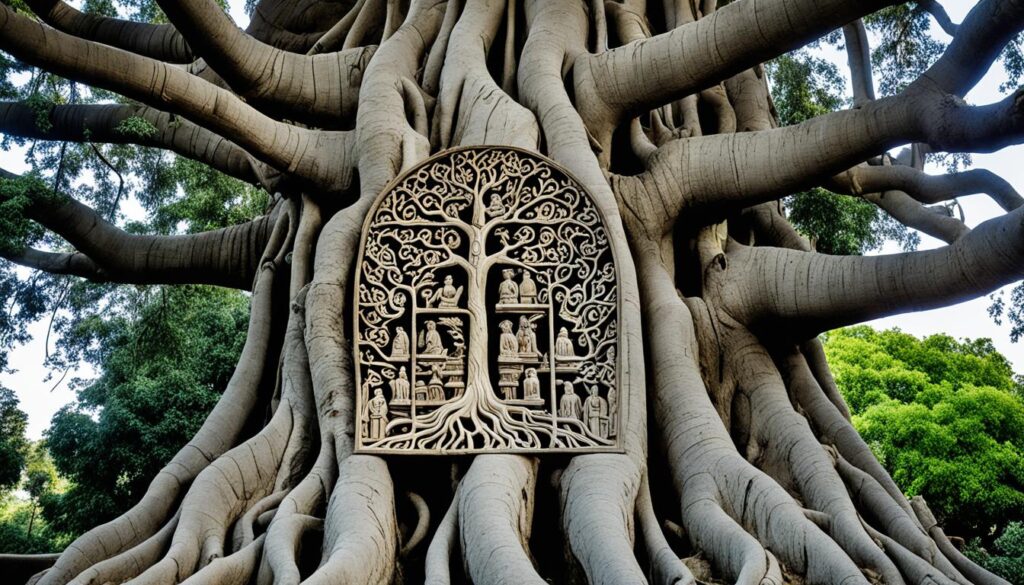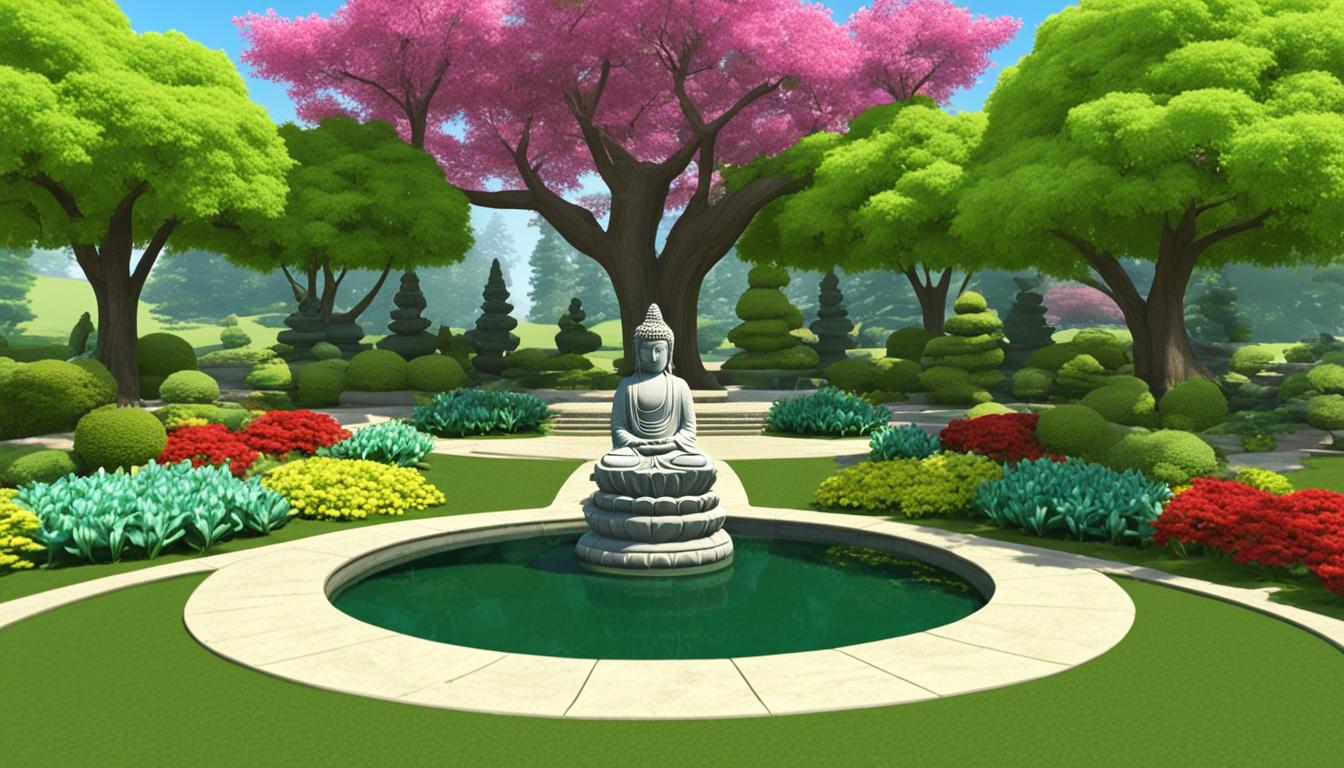Have you ever wondered about the different schools of Buddhism and what sets them apart? How do these schools interpret and practice the teachings of the Buddha? Discover the fascinating world of Buddhism as we delve into the diverse schools that exist today.
Buddhism encompasses a rich tapestry of teachings that have evolved over time, each offering unique perspectives on the path to enlightenment. From Theravada to Mahayana to Vajrayana, there is much to explore and learn. So, let’s embark on this spiritual journey together and unravel the mysteries of the schools of Buddhism.
Key Takeaways:
- There are various schools of Buddhism that have developed over time.
- Theravada, Mahayana, and Vajrayana are the major schools of Buddhism today.
- Each school offers its own unique practices, scriptures, and interpretations.
- All schools of Buddhism share fundamental teachings like the Four Noble Truths and the Eightfold Path.
- Exploring the diverse schools of Buddhism can enrich our understanding of this ancient tradition.
Understanding Theravada Buddhism
Theravada, also known as the “Teaching of the Elders,” is one of the oldest and most traditional schools of Buddhism. It is prevalent in Sri Lanka and Southeast Asia. Theravada practitioners focus on the study of the Pali Canon, the main collection of Buddhist scriptures. The Pali language is used in their rituals and teachings, and the monastic community plays a central role in the preservation of this tradition.
Exploring Mahayana Buddhism
Mahayana Buddhism, often referred to as the “Great Vehicle,” originated around the 1st century BCE. It is prominent in East Asia, including China, Japan, and Korea. Emphasizing compassion and insight as central doctrines, Mahayana teaches a path that aims to liberate all sentient beings.
Practitioners of Mahayana Buddhism strive to cultivate wisdom and compassion in order to attain enlightenment. The teachings encourage individuals to develop a deep understanding of the interconnectedness of all beings and the impermanence of the world.
Mahayana Buddhism is known for its focus on the Bodhisattva ideal, individuals who aspire to attain Buddhahood not only for their own liberation but also to help others achieve enlightenment. This compassionate approach stems from the belief that all beings have the potential to become Buddhas and should be guided towards liberation. By fostering compassion and insight, Mahayana practitioners aim to alleviate suffering and bring about the ultimate goal of enlightenment.
Famous Schools within Mahayana Buddhism
Within the Mahayana tradition, various schools have developed over time, each with its own unique practices and interpretations. Some of the most well-known schools include:
- Zen: Known for its emphasis on meditation and direct experience, Zen is a school of Mahayana Buddhism widely practiced in Japan. Zen teachings aim to cultivate sudden insight and understanding, often through the guidance of a Zen master or teacher.
- Pure Land: Pure Land Buddhism focuses on the devotion and faith in Amitābha Buddha. Practitioners seek rebirth in Amitābha’s Pure Land, a realm believed to be free from suffering, where the conditions for attaining enlightenment are favorable.
These schools, amongst others, offer different approaches to cultivating compassion and insight within the Mahayana tradition. While each school may have its own unique practices and rituals, the fundamental goal remains the same – to deepen one’s understanding and realization of the true nature of reality.
| School | Origin | Key Teachings |
|---|---|---|
| Zen | Origins in China, later majorly practiced in Japan | Emphasizes meditation, direct experience, and sudden insight |
| Pure Land | Origins in India, later practiced in various parts of Asia | Devotion to Amitābha Buddha, seeking rebirth in Pure Land |

Unveiling Vajrayana Buddhism
Embark on a journey to discover the profound wisdom of Vajrayana Buddhism, also referred to as the “Diamond Vehicle,” which emerged in the 5th century CE as an extension of Mahayana Buddhism. Vajrayana is predominantly practiced in Tibet, Bhutan, and the Himalayan region, where its rich traditions have flourished.
In Vajrayana, the path to enlightenment is propelled by the integration of tantric practices and rituals. These practices are designed to accelerate spiritual progress, allowing practitioners to achieve enlightenment swiftly and transcend the limitations of mundane existence. Through the intricate and profound methods of tantra, Vajrayana offers a direct and transformative approach to accessing the enlightened state.
The utilization of mantras, with their sacred vibrations, forms an integral part of Vajrayana practices. Mantras serve as powerful tools to connect practitioners with the divine energy, invoke blessings, and purify one’s mind and environment. By chanting mantras with devotion and concentration, practitioners align themselves with the divine essence, purify their negativities, and cultivate spiritual qualities.
Visualizations are another essential practice within Vajrayana Buddhism. By cultivating vivid mental imagery, practitioners engage their imaginative faculties to connect with enlightened beings, visualizing them as profound sources of inspiration and guidance. Through the art of visualization, practitioners develop a deep sense of connection and devotion, experiencing the presence of the divine within and around them.

The Historical Perspective
The schools of Buddhism have gone through a remarkable historical development, leading to the emergence of various schools with different interpretations and practices. After the death of Buddha, several councils were held to preserve his teachings and provide guidance to his followers. These councils played a significant role in shaping the future of Buddhism and eventually resulted in the formation of distinct schools.
Theravada, also known as the “Teaching of the Elders,” emerged as one of the earliest Buddhist schools. This school focuses on the Pali Canon, the collection of Buddhist scriptures that are believed to be the closest to the original teachings of the Buddha. Theravada remains prevalent in Sri Lanka and Southeast Asian countries.
Another key school that emerged during the historical development of Buddhism is Mahayana. Mahayana emphasizes compassion and insight as central doctrines and is prominent in East Asian countries such as China, Japan, and Korea. It offers a broader interpretation of the Buddha’s teachings and includes various practices like Zen meditation and devotion to the Buddha Amitabha.
As Buddhism spread to new regions, it further diversified into sub-schools and sects, adapting to different cultural and regional contexts. Tibetan Buddhism, often referred to as Vajrayana Buddhism, developed in the Himalayan region. It incorporates tantric practices, mantras, and visualizations to achieve enlightenment swiftly.
Despite the distinctions among the schools and their interpretations, the core teachings of Buddhism, such as the Four Noble Truths and the Eightfold Path, remain consistent. These teachings serve as the foundation for all Buddhist schools, guiding practitioners on their path to liberation from suffering.

| School | Key Features | Geographical Influence |
|---|---|---|
| Theravada | Emphasis on the Pali Canon, monastic community | Sri Lanka, Southeast Asia |
| Mahayana | Focus on compassion and insight, diversity in practices | China, Japan, Korea |
| Vajrayana | Incorporates tantric practices, mantras, and visualizations | Tibet, Bhutan, Himalayan region |
The Shared Core of Buddhism
Despite the differences among Buddhist schools, there are fundamental teachings that all schools share. The Four Noble Truths, the Eightfold Path, and the pursuit of Nibbana (Nirvana) are central to all forms of Buddhism.
These teachings emphasize the impermanence of life, the nature of suffering, and the path to liberation through ethical conduct, meditation, and wisdom.
Regardless of the specific school, these core principles guide Buddhist practitioners on their spiritual journey.
The Four Noble Truths
The Four Noble Truths are the foundation of Buddhist philosophy. They teach us about the nature of suffering and offer a path to overcome it.
- The truth of suffering (Dukkha): Life is characterized by suffering, dissatisfaction, and impermanence.
- The truth of the cause of suffering (Samudaya): Suffering arises from craving and attachment.
- The truth of the cessation of suffering (Nirodha): By eliminating craving and attachment, we can achieve liberation from suffering.
- The truth of the path to the cessation of suffering (Magga): The Eightfold Path leads us to the cessation of suffering and the attainment of enlightenment.
The Eightfold Path
The Eightfold Path is the practical guide to realizing the teachings of Buddhism and attain liberation. It consists of eight interconnected aspects or steps to live a virtuous and meaningful life.
- Right View: Understand the nature of reality and the Four Noble Truths.
- Right Intention: Develop wholesome and compassionate intentions.
- Right Speech: Speak truthfully, kindly, and avoid harmful speech.
- Right Action: Act ethically and refrain from harming others.
- Right Livelihood: Earn a living in a way that is honest and does not harm others.
- Right Effort: Cultivate positive qualities and abandon negative tendencies.
- Right Mindfulness: Develop awareness and present moment attention.
- Right Concentration: Cultivate deep meditative states to achieve insight and clarity.
Nibbana: The Ultimate Goal
Nibbana, also known as Nirvana, is the ultimate goal of Buddhism. It is a state of liberation from suffering, desire, and the cycle of rebirth. Nibbana is often described as the extinguishing of the flames of craving, ignorance, and delusion.
Attaining Nibbana is the ultimate aim of Buddhist practitioners, as it represents the complete end of suffering and the realization of true peace and freedom.

| Buddhist Concept | Description |
|---|---|
| Four Noble Truths | The foundational teachings on the nature of suffering and its cessation. |
| Eightfold Path | The path to liberation and the cultivation of virtue, mindfulness, and concentration. |
| Nibbana | The ultimate goal of Buddhism, representing the end of suffering and attainment of enlightenment. |
Conclusion
Buddhism is a fascinating and diverse spiritual tradition with a wide range of schools that offer distinct paths to enlightenment. From the traditional teachings of Theravada to the compassionate approach of Mahayana, and the tantric practices of Vajrayana, each school has its own unique perspectives and practices.
While there may be differences in rituals, scriptures, and interpretations among these schools, they all share a common goal: the pursuit of inner peace and liberation. Regardless of whether you follow the teachings of the Elders, the Great Vehicle, or the Diamond Vehicle, Buddhism offers guidance and inspiration for individuals on their spiritual journey.
Exploring the diverse schools of Buddhism allows us to gain a deeper understanding of the rich tapestry of this ancient tradition. Each school offers valuable insights and practices that can help us cultivate wisdom, compassion, and mindfulness in our lives. By embracing the teachings that resonate with us, we can integrate the principles of Buddhism into our daily lives and experience profound transformation.
In conclusion, whether you choose to explore Theravada, Mahayana, or Vajrayana, the wide range of schools within Buddhism reflects the multitude of paths that lead to enlightenment. The diverse perspectives and practices within Buddhism provide individuals with the freedom to find a spiritual path that resonates with their unique journey. Through the exploration of these diverse schools, we can embrace the rich heritage of Buddhism and unlock the potential for personal growth, inner peace, and liberation.
FAQ
What are the different schools of Buddhism?
The different schools of Buddhism include Theravada, Mahayana, and Vajrayana, among others.
What is Theravada Buddhism?
Theravada Buddhism, also known as the “Teaching of the Elders,” is one of the oldest and most traditional schools of Buddhism. It is prevalent in Sri Lanka and Southeast Asia.
What is Mahayana Buddhism?
Mahayana Buddhism, often referred to as the “Great Vehicle,” originated around the 1st century BCE. It is prominent in East Asia, including China, Japan, and Korea.
What is Vajrayana Buddhism?
Vajrayana Buddhism, also known as the “Diamond Vehicle,” is an extension of Mahayana Buddhism. It emerged in the 5th century CE and is primarily practiced in Tibet, Bhutan, and the Himalayan region.
What is the historical development of Buddhist schools?
After the Buddha’s death, various councils were held to preserve and interpret his teachings, resulting in the formation of different schools, such as Theravada and Mahayana. These schools further branched out into sub-schools and sects over the centuries.
What are the core teachings shared by all Buddhist schools?
The core teachings shared by all Buddhist schools include the Four Noble Truths, the Eightfold Path, and the pursuit of Nibbana (Nirvana). These teachings emphasize the impermanence of life, the nature of suffering, and the path to liberation through ethical conduct, meditation, and wisdom.

